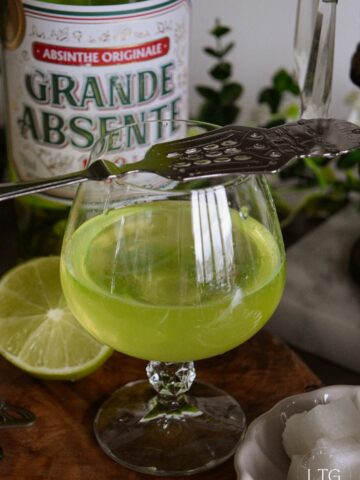This post has been brought to you by Liquore Strega. All opinions expressed are my own. The following message is intended for those 21+. Please enjoy responsibly.

Today we’re reviewing the liqueur that gave rise to a thousand “Witches Cocktails,” known lovingly as the “Witches’ Brew of Benevento” – Liquore Strega.
We’ll be talking a little about this liqueur’s history, and how it became so closely associated with “Witchery,” and then we’ll move on to tasting and aromatics, followed by some of my favorite Strega-based cocktails.
Strega – Of the Witches of Benevento, The Goddess of Death, and a Liqueur Most Floral
Believe it or not, Strega’s story starts in the tumult of the fourth century during the waning days of Rome’s Tetrarchy, the period after the Empire had been divided into three administrative zones by Emperor Diocletian.
During this time, in the years just prior to, and immediately after, the ascendance of Emperor St. Constantine to the imperial throne of the Roman Empire, ending the Tetrarchy, there was a ‘moment’ as curious as it was fleeting. During this briefest and most curious of times, one could walk the streets of the great metropolises of antiquity, flanked by soaring columns of cloud-white marble, and turn up the wide stairs of a temple of such ancient deities as Apollo, Zeus or Hera, and cross through its towering bronze doors to approach the incense veiled altar of one of these many “Gods of Old.” It was not unthinkable for this temple to be directly across or down the street from an Orthodox Christian Church, though this church was probably ‘much’ less grand in its design and structure than its counterpart temple.
However, by this point in history, ‘if’ you entered a pagan temple (a larger ‘if’ than one might imagine), you were very likely to be but one of a handful of attendees, several of whom were almost certainly not ‘devotees’ themselves, but who were instead merely taking in the sights and sounds, or perhaps attending a festival or a political gathering. The priest or priestess of said temple was also more likely than not to be very advanced in years, and almost certainly without a successor – clerical recruiting during this period was notoriously difficult except via direct political appointment. Indeed, from Cordoba to Athens, and from Rome to Londinium, the Greco-Roman Pantheon was dying a natural, and agonizingly slow, death at the hands of not just Christianity – which was spreading like wildfire despite repeated waves of persecution – but also to a host of other Near East religions. For example, the average Roman soldier, at this time, was more likely to be devoted to Mithras, a Persian deity, than to Ares.
The crowning of Emperor St. Constantine would be the final stake in the heart of the Empire’s Greco-Roman pantheon, a pantheon that had become bloated by provincial deities and emperor worship, and corrupted by politics.
I promise there’s a reason I’m talking about this.
And here it is.
This ‘moment’ of coexistence persisted longer in some areas than it did in others, and that ‘persistence’ gave rise over time to various myths, superstitions, and folklores – some of which have survived into the modern era.
In Benevento, for example, where the Cult of Isis, the Egyptian Goddess of death, had been prominent for nearly a thousand years by the time of the Western Roman Empire’s collapse, pagan rituals and customs proved particularly lasting. Evidence of this local cult persisted well into the seventh century, with a local Lombardic Duke by the name of Romuald (Italicized to ‘Romualdo’), worshiping a “golden viper with wings or two heads,” one of the many incarnations of Isis.
This gave rise to the myth of the “Witches of Benevento.”
For those who aren’t familiar, the “Witches of Benevento” myth boils down to Benevento, or its countryside, being a popular gathering place for witches, in particular an old walnut tree. This tree has never been positively identified. This myth was taken very seriously, and these ‘witches’ were the subject of investigations, inquisitions, and scholarly work well into the mid-18th century. Yes, roughly one and half thousand years after Rome had officially abandoned its pantheon.
By the dawn of the 19th century, the ‘Witches of Benevento’ had thankfully entered the realm of popular folklore and ghost stories. By the 1850s, inquiry into the alleged witches had sufficiently cooled off to the point where local entrepreneurs could begin making light of their home region’s quirks – some even going so far as to turn it into a marketing convention.
Enter Carmine Vincenzo Alberti and Giuseppe Alberti, who were what we might today dub a father and son ‘mixology team.’
The pair concocted a ‘brew’ of some seventy herbs and flavoring agents, including saffron and mint, from which the distilled liquid receives its green tinged golden color, and dubbed the resulting liqueur Strega, or ‘Witch.’
Tasting and Aromatics – The Review
The bouquet is intense and quite thick, carrying a host of mixed herbs, both fresh and dried. Think pine and juniper, with copious anise, and just a dash of peppermint, while rich floral notes make themselves known from time to time. Mint, while present, is assuredly a background aroma, and I likely wouldn’t have picked it up if I hadn’t been searching for it. On the palate, saffron and mint are what dominate, combining to warm and coat the mouth. This combination veils, but doesn’t obscure, the rest of the liqueur’s flavor profile, courtesy of its substantial ingredient list. Cloves, honey, and vanilla, are foremost among these flavors. Anise is present, as is a dusting of mixed fresh herbs. While Strega isn’t what I would normally consider a ‘sweet liqueur,’ it is definitely on the sweeter end of the spectrum.
Unique, intense, and delicious. Strega is definitely worth trying if you haven’t already.
How Best to Enjoy Strega
While Strega is perfectly palatable on its own, there are number of cocktails worth trying out. Here are a few ways I suggest enjoying this liqueur.
1) Neat. On its own or ‘neat’ is probably my favorite way to enjoy Strega, preferably after a meal, and usually to cap off dessert.
2) Witch’s Flight. A delightfully simple after dinner cocktail, one that uses sugar to bring out Strega’s natural tartness. This cocktail is equal parts bourbon whiskey, Strega, amaro, and lemon juice. Simply combine those ingredients in equal amounts ( about three quarters of an ounce), and then shake well and strain into a chilled glass.
3) Witch Hunt. Another very simple cocktail, but this is one I’d suggest either as an aperitif or as an ‘under the sun’ cocktail. This cocktail is one and half ounces of Scotch, a half an ounce of dry vermouth, and two ounces of Strega, finished with one ounce of lemonade. Simply combine in a glass, stir, and enjoy.
4) Witch’s Daiquiri. A Strega twist on the ubiquitous daiquiri. Shake together an ounce of rum, two thirds of an ounce of Strega, a third ounce of simple syrup flavored with almond, and a half ounce each of fresh lemon juice and fresh orange juice. Strain into a chilled glass.
Noticing a pattern in the naming convention yet?
5) Death Star. Probably the ‘booziest’ cocktail on this list, and definitely more of a digestif or nightcap as opposed to an aperitif. This is an ounce each of Barsol Pisco, Strega, amaro, and a dash of grapefruit bitters. Stir, then strain into a chilled glass.
6) Witch’s Grappa. Another super simple cocktail, as most Strega creations are – due to Strega’s inherent complexity. This is simply an ounce each of Grappa, Strega, and fresh orange juice, plus a half ounce of fresh lemon juice. Shake with ice, then strain into a chilled glass.
Witch’s Daiquiri
- Total Time: 5 minutes
- Yield: 1 cocktail 1x
Ingredients
- 1 ounce rum
- 2/3 ounce Liquore Strega
- 1/3 ounce almond syrup
- 1/2 ounce fresh lemon juice
- 1/2 ounce fresh orange juice
Instructions
- Squeeze the fresh lemon and orange juice and strain.
- In a cocktail mixing glass, combine, rum, Liquore Strega, almond syrup, and fresh citrus juice.
- Stir and pour into your desired cocktail glass.
- Best if served chilled.
- Prep Time: 5 minutes
- Category: Drinks










Heather says
I haven't heard of this drink before. It sounds refreshing! I'll have to make it for family at our next get together.
Risa Lopez says
Thank you for the recipe. It looks like it is easy to make. Looks so good.
Bohemian Interiors says
This looks so so good! Witches Daiquiri, that is the first time I hear about it. I will try it out for sure.
Yeah Lifestyle says
I loved reading your post especially the history behind Strega’s story and then the drink somehow made sense. I hope to remake Witches Daiquiri at home
Kat says
I've never tasted this. Witch’s Grappa is going to be a great cocktail drink over weekend parties. I must try this!
Paula Richie says
Thanks for this history. I've never had a daquiri but don't think I'd want this one with its "association" with witchery.